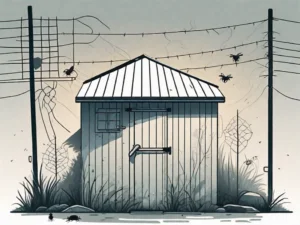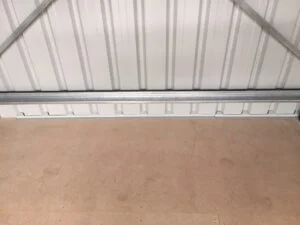Vermin Proofing Your Shed – Your Ultimate Guide
As we all know, vermin infestation can cause significant damage to our belongings and property. Whether it’s rats, mice, or other pests, these uninvited guests can wreak havoc in our sheds, storage spaces, and outdoor buildings. Fortunately, there are effective strategies that can help keep vermin out of your shed and protect your valuables. In this article, we will explore various methods to deter vermin and maintain a vermin-free shed.

Understanding Vermin Behaviour
Before we dive into the strategies, it’s important to understand why vermin are attracted to your property in the first place. Vermin are constantly seeking food, water, shelter, and warmth to survive. By eliminating these attractants, we can discourage them from making our sheds their cozy hideouts.
Vermin, such as rats and mice, have adapted to living in close proximity to humans. They have learned to take advantage of the resources we provide, making our homes and sheds attractive places for them to thrive. Understanding the factors that attract vermin to your property is crucial in effectively managing and preventing infestations.
Factors that Attract Vermin to Your Property
Vermin are drawn to areas where they can find easy access to food and water sources. Poorly sealed garbage bins, uncovered pet food dishes, and bird feeders can all lure vermin to your shed. These sources of sustenance provide a consistent and reliable food supply for them.
Additionally, a cluttered and unkempt surrounding area provides vermin with ample hiding spots and nesting materials. Piles of debris, overgrown vegetation, and untrimmed shrubs create ideal environments for vermin to establish their nests and breed.
Furthermore, vermin are attracted to the warmth and shelter that sheds provide. These structures offer protection from the elements, making them attractive nesting sites. Cracks in the walls, gaps under doors, and broken windows serve as convenient entry points for vermin to access the shed.
Natural Repellents to Keep Vermin Away
One effective way to deter vermin is by using natural repellents that they find unpleasant. For instance, peppermint oil can be applied to cotton balls and placed strategically around your shed to repel rodents. The strong scent of peppermint acts as a deterrent, making the shed an unappealing environment for vermin.
Similarly, dried mothballs or cayenne pepper can be sprinkled near potential entry points to discourage vermin from approaching. The pungent odour of mothballs and the spicy nature of cayenne pepper are known to repel vermin, making them less likely to venture near your shed.
It’s important to note that while natural repellents can be effective in deterring vermin, they may not provide a fool proof solution. Vermin are adaptable creatures and may eventually become accustomed to the repellents. Therefore, it’s essential to combine repellents with other preventive measures to ensure long-term success in keeping vermin away from your property.
The Dangers of Vermin Infestation
Vermin infestation may seem like a minor inconvenience, but it can have serious consequences for your shed and its contents.
Imagine this: you walk into your shed one day, ready to retrieve your gardening tools, only to find that they have been chewed to bits. The culprit? Vermin. These pesky creatures have a knack for chewing through various materials, including wood, plastic, and even electrical wires. Not only does this lead to structural damage to your shed, risking its stability, but it also leaves you with ruined belongings.
But the damage doesn’t stop there. Vermin droppings can contaminate surfaces, spreading bacteria and diseases. As you reach for that rusty spade, unaware of the invisible danger lurking on its handle, you unknowingly expose yourself to potential health hazards. The diseases transmitted by vermin can range from mild to severe, causing symptoms such as fever, nausea, and even respiratory problems.
It’s not just your shed that is at risk. Vermin can easily find their way into your home, making themselves comfortable in the cozy corners of your attic or basement. From there, they can wreak havoc on your electrical system, gnawing through wires and increasing the risk of electrical fires. The damage caused by vermin infestation can be costly to repair and can put the safety of your entire household at risk.
Common Damages Caused by Vermin
Now that you understand the potential dangers of vermin infestation, let’s take a closer look at the common damages they can cause.
When it comes to structural damage, vermin have no boundaries. They can chew through wooden beams, weakening the overall stability of your shed. This not only poses a risk to the shed itself but also to anyone who enters it. Imagine the horror of stepping into your shed, only to have the floor give way beneath you.
Plastic items are not safe from vermin either. They can gnaw through plastic storage containers, rendering them useless and leaving your belongings exposed to the elements. Your carefully organized shed can quickly turn into a chaotic mess, with vermin leaving their mark on everything they touch.
Electrical wires are like a gourmet meal for vermin. They love sinking their teeth into the rubber insulation, exposing the live wires underneath. This not only increases the risk of electrical fires but also poses a danger to anyone attempting to fix or use the electrical system. It’s a ticking time bomb waiting to go off.
Vermin droppings may seem harmless, but they are far from it. These droppings can contain harmful bacteria and viruses that can cause a range of diseases. From salmonella to hantavirus, the list of potential health hazards is alarming. The contamination can spread to surfaces in your shed, making it a breeding ground for pathogens.
So, the next time you spot a few droppings or hear the faint scurrying of tiny feet in your shed, don’t dismiss it as a minor inconvenience. Take action immediately to prevent further damage and protect the safety of your shed, belongings, and most importantly, your health.
Building a Vermin-Proof Shed
When constructing a new shed or considering renovations, incorporating vermin-proofing measures can go a long way in preventing infestations in the future.
Vermin, such as rats and mice, can cause significant damage to sheds and their contents. They can chew through materials, create nests, and contaminate stored items. Therefore, taking proactive steps to make your shed vermin-proof is essential.
Essential Materials and Design Features
Choosing the right materials for your shed is crucial. Opt for durable materials like metal or pressure-treated wood that are less prone to vermin damage. These materials are less appealing to rodents and can withstand their attempts to gnaw through.
Additionally, ensure that the shed has a solid foundation and raised floor to deter access from burrowing vermin. By elevating the shed, you create an additional barrier that makes it harder for vermin to infiltrate.
Consider incorporating a concrete or gravel base for your shed. These materials make it difficult for rodents to dig underneath and gain entry. Furthermore, a raised floor can help prevent moisture build-up, which can attract vermin.
Effective Vermin Sealing Techniques
Sealing your shed’s potential entry points is paramount in keeping vermin at bay. Inspect and seal any gaps, cracks, or holes around doors, windows, and vents. Vermin can squeeze through surprisingly small openings, so it’s important to be thorough in your inspection.
Implementing Vermin Seal is an effective solution, which not only keeps vermin at bay but also helps weather proof your shed against rain and moisture. This is installed under the sheets to seal the profiles of the sheets and the gap between the sheet internal face and edge of the slab.

Vermin Seal Example (above)
Use caulk or expanding foam to seal gaps in the walls, floor, and ceiling. Pay close attention to areas where utility lines enter the shed, as these are common entry points for vermin. By sealing off these access points, you significantly reduce the chances of a vermin infestation.
Mesh screens and weather-stripping can also be installed to further fortify these vulnerable areas. Mesh screens can be placed over vents and openings to allow airflow while keeping vermin out. Weather-stripping can be applied around doors and windows to create a tight seal, preventing any gaps that vermin could exploit.
Regular maintenance is also crucial in ensuring the long-term vermin-proofing of your shed. Inspect the shed periodically for any signs of damage or potential entry points. By addressing any issues promptly, you can prevent vermin from finding their way in.
In conclusion, building a vermin-proof shed requires careful consideration of materials, design features, and sealing techniques. By taking these measures, you can create a shed that is resistant to vermin infestations, providing a safe and secure storage space for your belongings.
Preventing Vermin Entry Points
While building a vermin-proof shed is essential, it’s equally important to prevent vermin from finding their way into your existing shed. Vermin, such as rats and mice, are notorious for their ability to squeeze through tiny openings and exploit any vulnerabilities in your shed’s structure. By taking proactive measures to seal off potential entry points and maintaining a clean surrounding area including removing concrete floor stains, you can greatly reduce the risk of vermin intrusion.
Promptly Repairing Leaks and Cracks
Vermin are opportunistic creatures, always on the lookout for a cozy shelter and a reliable food source. They can exploit even the tiniest openings, such as gaps around windows, doors, and vents. Regularly inspect your shed for any leaks or cracks, no matter how small they may seem, and promptly repair them using caulk or other suitable sealants. By eliminating moisture and creating a tight seal, you can greatly reduce the chances of vermin finding their way inside.
It’s important to pay close attention to areas where different materials meet, such as where the shed’s walls meet the foundation or the roof. These junctions can sometimes develop gaps or separations over time, providing vermin with easy access. By carefully inspecting and reinforcing these areas, you can effectively fortify your shed against vermin intrusion.
Maintaining a Clean Surrounding Area
Vermin are attracted to cluttered and untidy environments, as they provide them with ample hiding spots and potential nesting areas. To discourage vermin from approaching your shed, it’s crucial to maintain a clean and well-organized surrounding area.
Start by removing any debris or unnecessary items that may be stored near the shed. Piles of wood, old furniture, or unused equipment can serve as ideal hiding spots for vermin. By keeping the area around your shed clear and free of clutter, you eliminate potential shelter for these unwanted guests.
In addition to removing debris, it’s important to regularly trim overgrown vegetation around the shed. Dense bushes, tall grass, and tree branches that touch or hang over the shed can provide vermin with easy access. By keeping the surrounding vegetation well-maintained, you create a physical barrier that makes it more difficult for vermin to approach your shed.
Another crucial step in maintaining a vermin-free shed is to store firewood away from the shed. Firewood piles can attract vermin, as they provide both shelter and a potential food source. To minimize the risk of vermin infestation, store firewood at least 20 feet away from the shed and elevate it off the ground.
Lastly, regularly clean up any spilled food or garbage near the shed. Vermin are scavengers and are always on the lookout for easy meals. By eliminating potential food sources, you remove the incentive for vermin to approach your shed in search of sustenance.
By implementing these preventive measures, you can significantly reduce the likelihood of vermin finding their way into your shed. Remember, prevention is key when it comes to dealing with vermin, so it’s important to be proactive and regularly inspect and maintain your shed and its surrounding area
Maintaining a Vermin-Free Shed
Keeping your shed vermin-free requires consistent effort and maintenance. Vermin, such as rats, mice, and insects, can cause damage to your shed and its contents, as well as pose health risks. To ensure a vermin-free environment, it is important to implement effective strategies and best practices.
Best Practices for Cleaning and Organizing
Regular cleaning and organizing can significantly reduce the appeal of your shed to vermin. Wipe down surfaces, sweep away debris, and vacuum the shed regularly to eliminate any traces of vermin attractants. Vermin are attracted to food sources, so it is crucial to keep any food items properly stored in sealed containers. This includes pet food, birdseed, and any other edible items that may be stored in the shed.
Additionally, organizing your belongings in sealed containers can prevent vermin from nesting in them. Cardboard boxes and bags are easily chewed through by rodents, so opt for plastic or metal containers with tight-fitting lids. This will not only protect your belongings from vermin but also help keep them organized and easily accessible.
Furthermore, it is important to regularly inspect and maintain the exterior of your shed. Check for any cracks, holes, or gaps that could serve as entry points for vermin. Seal these openings with caulk or steel wool to prevent vermin from entering. Pay special attention to areas where utility lines enter the shed, as these are common entry points for rodents.
Another effective strategy is to install a vermin-proof door sweep. This will create a barrier between the bottom of the shed door and the ground, preventing vermin from squeezing through small gaps. Make sure the door sweep is in good condition and free from any damage or wear that could compromise its effectiveness.
Furthermore, consider using natural repellents to deter vermin from entering your shed. Peppermint oil, for example, is known to repel rodents due to its strong scent. Soak cotton balls in peppermint oil and place them strategically around the shed, focusing on areas where vermin are likely to enter. Alternatively, you can plant mint near the shed to create a natural barrier.
In conclusion, implementing effective strategies to keep vermin out of your shed is essential for maintaining its integrity and protecting your valuables. By understanding vermin behavio`r, employing natural repellents, building vermin-proof sheds, preventing entry points, and maintaining cleanliness, you can greatly reduce the risk of vermin infestation. Remember, a proactive approach is key to keeping these unwanted visitors at bay and enjoying a vermin-free shed for years to come.



 1300 778 628
1300 778 628






